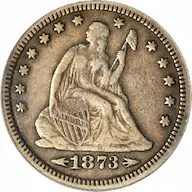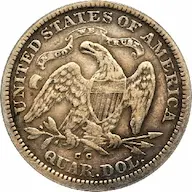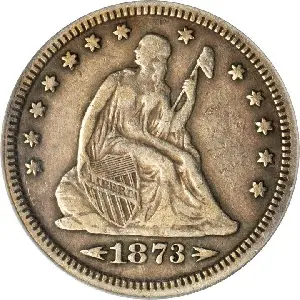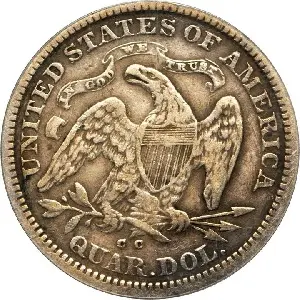1873-CC Seated Liberty Quarter, Arrows
By the early 1870's, even the most casual observer may have taken notice of the oddities within the United States coinage system. Consider these facts:(1)
- A two cent coin that few people used was being minted.
- There were two different three cent coins circulating, one made of silver and the other nickel.
- Ditto for five cent coins.
- Dollar coins were issued in both gold and silver.
Many in Congress saw the need to simplify the nation's coinage system, and went to work crafting legislation to do just that. On February 12, 1873, President Grant signed into law the Coinage Act of 1873. This law provided for:
- The elimination of the two cent coin, the silver three cent coin, the silver half dime, and the silver dollar (thus ending the right of holders of silver bullion to have it coined into standard dollars -- this became a major controversy in a few years).
- The silver content of the dime was increased by about 4.8%, to 2.50 grams. The quarter, and half dollar were increased likewise to 6.25 grams and 12.50 grams, respectively. This was done to place the U.S. in harmony with the silver coinage of Europe, hence the metric weight units.
- Authorized the minting of Trade Dollars.
The weight increase went into effect April 1, 1873. Arrows were added to the date of the effected coins to denote the change. The new obverse dies (with arrows) arrived from Philadelphia in Carson City in June. By the dog days of summer, a scant 12,462 quarters bearing the 1873-CC with Arrows date had been struck, the final tally for the year.(2)
The Mint had suspended specie payments in 1861 during the early months of the Civil War, and that policy was still effective in 1873. The Philadelphia Mint provided coins for banks and businesses upon request, but the branch mints were ordered not to pay out subsidiary silver coins except under very limited circumstances, one of those being if a gold depositor was owed change of less than one dollar after settlement.(3)
With these strict conditions, few quarters were being paid out, explaining why the Carson City Mint struck only small mintages in the years 1870-1873, and none in 1874. This too describes how other surviving “CC” silver rarities initially reached the public.
It seems likely that a significant percentage of 1873-CC Arrows quarters never left the Mint and may have been melted alongside the lighter weight 1873-CC No Arrows quarters (of the 4,000 of those that were struck, we know of only six specimens existing today).
The 1873-CC Arrows quarter date is rare and in high demand in all grades. If past performance is any clue (it usually is), then collectors fortunate to own this key date prize have much to enjoy in the years ahead as its value continues to climb.
| Estimated survivors in all grades: 50 ?
The survivor estimate from PCGS represents an average of one or more experts' opinions as to how many examples survive of a particular coin in all grades. Survival estimates include coins that are raw, certified by PCGS, and certified by other grading services. Learn more at PCGS. |
| PCGS Rarity Scale: 8.5 ?
The 'PCGS CoinFacts Rarity Scale' assesses the relative rarity of all U.S. coins, based on estimated surviving examples. The scale runs from 1.0 to 10.0. The higher the number, the rarer the coin.
Learn more at PCGS. |
| Search for the 1873-CC Seated Liberty Quarter, Arrows on eBay** |
Preview of eBay selection (a few more 1873-CC quarters may be found through Search link above):
 |
 |
| Trendline Avg = 19.74 | BETTER |
 |
 |
| Trendline Avg = 19.74 | BETTER |
Historic Value Trend Charts:
| Last updated 4-8-25 | Return to Key Date Coin List | |
| Compare to Common Date Coin of Same Type | ||
|
|
||
| Download Charts to Your Computer | ||
Sources
1. Taxay, Don. The U.S. Mint and Coinage. New York, NY: Sanford J. Durst Numismatic Publications, 1966.
2. NGC. 1873 CC ARROWS 25C MS.
3. Heritage Auctions. 1873-CC 25C Arrows. Oct 2018 Auction.
**Many very fine coin dealers sell on eBay. At any point in time, there may be over one million search results for United States coins. This includes quite a few of the recommendations on our Key Date Coin List.
If you’re thinking about purchasing a rare coin, eBay is certainly worth a look. For your convenience, the links from this site to eBay are coded to bring up only coins certified by PCGS and NGC.
As is always, always the case, never buy a valuable coin from a seller whose trustworthiness cannot be verified. Learn more about this at our chapter Best Places to Buy Coins, which also has a section on doing business on eBay.
In the interest of full disclosure, Rare Coins 101 receives a small commission anytime someone connects to eBay from this site and purchases something.
Coin images by Stack's Bowers Galleries.


